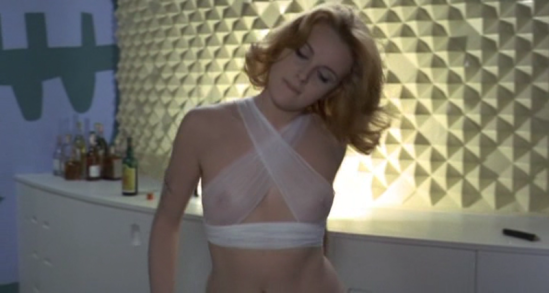
Piero Schivazappa’s Femina Ridens (1969), or The Laughing Woman, posits that Modernism, as a series of aesthetic principles, is the last bulwark against the tide of progress. Schivazappa’s direction solicits highly mannered performances from Philippe Leroy and Dagmar Lassander while visually embracing Modernist trends to the point of high camp. These choices place Femina Ridens in the same tradition as films like Mr. Freedom (1968) and Eden & After (1970) whereby stylistically plastic narrative constructs become a means of political commentary.
All of the Modernist tendencies are aligned with the Philippe Leroy character Dr. Sayer who has abducted the ambitious journalist Mary (Dagmar Lassander). The kinky rituals of dominance and submission that Dr. Sayer forces Mary to undergo reflect his belief in masculine superiority. Dr. Sayer’s motives are to rebel against feminism which he perceives as an attack on masculinity. However Schivazappa’s Brechtian reflexivity keeps Femina Ridens devoid of emotional sensationalism and melodrama.
Mary is always the empathetic center of Femina Ridens. In the cold, mannered world of Dr. Sayer the spectacle is one of survival; survival in the face of a misogyny embodied by Modernist designs and architecture. Schivazappa’s Theatre of Cruelty plays out amongst eye-popping set pieces that, even at their most violent and vile, are gorgeous to look at. Sante Achilli’s cinematography transforms these brilliant sets into a kaleidoscope of colors and textures whilst Schivazappa’s blocking (particularly of Mary’s famous striptease scene) plays up the theatricality of the performances while embracing the Modernist aesthetic.
The recent rediscovery and critical reassessment of Femina Ridens points to its current relevance as a sexually transgressive text. That Femina Ridens is an indisputable triumph of cinematic technique only aids the film’s longevity. It’s Femina Ridens‘ tale of misogyny conquered that holds the movie’s real appeal for today’s audience. Schivazappa explodes Femina Ridens‘ third act into a pastiche of sixties romance movies where Mary and Dr. Sayer seem to exist as sexually liberated equals. This utopia is heralded by a passing train carrying an all girl band; a tongue-in-cheek moment of self-deprecation.
As Femina Ridens draws to a close the two central figures of Schivazappa’s psycho-sexual pagent leave their Modernist trappings briefly and journey back to Italy’s Medieval period by way of a restaurant in a castle. After which, in a sequence of pure fantasy, Dr. Sayer disappears into a gigantic, wholly Modernist sculpture of a woman’s open legs only to emerge a skeleton. In a twist ending Mary has killed Dr. Sayer and Schivazappa reveals that Mary is part of a conspiracy to “hit back” at the men who prey upon women. Mary is a sort of feminist Modesty Blaise dolling out vigilante justice for women everywhere.
A political reading of Femina Ridens is a relatively easy endeavor. Dr. Sayer kills his victims at the moment of their sexual climax and Mary must escape and triumph over the doctor. Femina Ridens is a film about the feminist struggle in Italian society. But as a document of sexual morality Femina Ridens is a little more ambiguous. The kinkiness of the film exists only in the arena of the battle between Dr. Sayer and Mary and could therefore be read as sex-negative. Yet, with the absence of emotionality to the performances, the spectacle of this struggle titillates and diverts in much the same way as pornography. Femina Ridens is a heterosexual male fantasy that, ultimately, is about male submissiveness to the female. In the exclusively binary terms of sixties sexual politics this is a subversive gesture on Schivazappa’s part.
